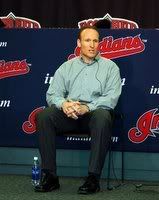Indians  Indians Archive
Indians Archive  Life On A Shoestring
Life On A Shoestring
 Indians Archive
Indians Archive  Life On A Shoestring
Life On A Shoestring
Written by
Erik Cassano
 On the same day that the Indians signed a relief pitcher who just failed a physical in Philly to a one year deal, the Red Sox spent 106 million dollars on J.D. Drew and Julio Lugo. And Papa Cass is jealous. In his latest, he makes a good point. The Indians keep talking about building for the long-term. So why are so many of their solutions short-term?
On the same day that the Indians signed a relief pitcher who just failed a physical in Philly to a one year deal, the Red Sox spent 106 million dollars on J.D. Drew and Julio Lugo. And Papa Cass is jealous. In his latest, he makes a good point. The Indians keep talking about building for the long-term. So why are so many of their solutions short-term?
 Pardon me for feeling a little jealous.
Pardon me for feeling a little jealous.
It's just that whenever I look at the Indians' offseason activity, and then look at the offseason moves of other teams, I'm reminded of a few lines from the Everclear song, "I Will Buy You a New Life":
"I hate all those people who love to tell you,
Money is the root of all that kills.
They have never been poor,
They have never had the joy of a welfare Christmas."
I flick on SportsCenter and find out that the Red Sox have signed J.D. Drew and Julio Lugo on the same day. That's $70 million for Drew and $36 million for Lugo. Within the span of 24 hours. And Manny Ramirez is still on their roster raking in $20 million a year, or some obscenely-high amount around there.
Then I click on the Web at work Wednesday to find out that the Indians have rolled the dice on yet another pitcher other teams have shied away from due to injury concerns. One year, and a shade over $4 million for Joe Borowski.
Borowski would have been a Phillie by last week if it wasn't for an MRI on his shoulder. The Phillies saw something they didn't like and pulled their multi-year offer off the table, essentially sending Borowski to the scratch-'n-dent bin.
Enter the Indians, baseball's scavengers. They must have seen the same things the Phillies saw when Borowski came in for his Cleveland physical Tuesday. It's amazing what a suddenly-cheap price and an air of quasi-desperation on both sides will do for getting a deal done.
Borowski needed to go somewhere to rescue his market value and clear his shoulder of any wrongdoing. The Indians needed a veteran late-inning reliever and couldn't afford much else. A match made in clearance-rack heaven.
Both Borowski and the Indians are rolling the dice that his shoulder will stay intact for the 2007 season.
If all goes well, the Indians can pick up Borowski's option for 2008. If all doesn't go well, he's gone after the season.
You could certainly do worse then Borowski, a journeyman reliever who has managed to last more than a decade in the majors. But he's still a one- or two-season bandage, like Bob Wickman last year and the year before, like Kevin Millwood, like Bob Howry and Scott Sauerbeck, like Roberto Hernandez and Aaron Fultz.
The Indians keep talking about building for the long-term. So why are so many of their solutions short-term?
Every offseason, we are led to believe that this year is the year the Indians make some meaningful strides in trades and free agency, and finally turn from a potential-laden young club to an American League contender. But every offseason, the Indians become baseball's Ellis Island, a gateway for baseball's tired, huddled, injury-plagued masses yearning to reclaim their careers.
It perpetuates the feeling that, even with the impressive collection of young talent, this team is still living hand-to-mouth, year-to-year. It doesn't exactly instill confidence in the players or fans that this team is building toward consistent contention.
And all the while, we get to watch ESPN every night and be regaled by the epic stories of the Yankees, Red Sox and their big-market ilk engaged in their ongoing games of financial one-upmanship.
You can see why the temptation is to go back to bed, pull up the covers and say, "Wake me when my ship comes in."
 Pardon me for feeling a little jealous.
Pardon me for feeling a little jealous.It's just that whenever I look at the Indians' offseason activity, and then look at the offseason moves of other teams, I'm reminded of a few lines from the Everclear song, "I Will Buy You a New Life":
"I hate all those people who love to tell you,
Money is the root of all that kills.
They have never been poor,
They have never had the joy of a welfare Christmas."
I flick on SportsCenter and find out that the Red Sox have signed J.D. Drew and Julio Lugo on the same day. That's $70 million for Drew and $36 million for Lugo. Within the span of 24 hours. And Manny Ramirez is still on their roster raking in $20 million a year, or some obscenely-high amount around there.
Then I click on the Web at work Wednesday to find out that the Indians have rolled the dice on yet another pitcher other teams have shied away from due to injury concerns. One year, and a shade over $4 million for Joe Borowski.
Borowski would have been a Phillie by last week if it wasn't for an MRI on his shoulder. The Phillies saw something they didn't like and pulled their multi-year offer off the table, essentially sending Borowski to the scratch-'n-dent bin.
Enter the Indians, baseball's scavengers. They must have seen the same things the Phillies saw when Borowski came in for his Cleveland physical Tuesday. It's amazing what a suddenly-cheap price and an air of quasi-desperation on both sides will do for getting a deal done.
Borowski needed to go somewhere to rescue his market value and clear his shoulder of any wrongdoing. The Indians needed a veteran late-inning reliever and couldn't afford much else. A match made in clearance-rack heaven.
Both Borowski and the Indians are rolling the dice that his shoulder will stay intact for the 2007 season.
If all goes well, the Indians can pick up Borowski's option for 2008. If all doesn't go well, he's gone after the season.
You could certainly do worse then Borowski, a journeyman reliever who has managed to last more than a decade in the majors. But he's still a one- or two-season bandage, like Bob Wickman last year and the year before, like Kevin Millwood, like Bob Howry and Scott Sauerbeck, like Roberto Hernandez and Aaron Fultz.
The Indians keep talking about building for the long-term. So why are so many of their solutions short-term?
Every offseason, we are led to believe that this year is the year the Indians make some meaningful strides in trades and free agency, and finally turn from a potential-laden young club to an American League contender. But every offseason, the Indians become baseball's Ellis Island, a gateway for baseball's tired, huddled, injury-plagued masses yearning to reclaim their careers.
It perpetuates the feeling that, even with the impressive collection of young talent, this team is still living hand-to-mouth, year-to-year. It doesn't exactly instill confidence in the players or fans that this team is building toward consistent contention.
And all the while, we get to watch ESPN every night and be regaled by the epic stories of the Yankees, Red Sox and their big-market ilk engaged in their ongoing games of financial one-upmanship.
You can see why the temptation is to go back to bed, pull up the covers and say, "Wake me when my ship comes in."
Posted by
Erik Cassano
Dec 06, 2006 7:00 PM
- NBA Announces 2013-2014 Schedule
- Browns Ink Sharknado
- Sharknado A No-Show For Rookie Camp
- Trent Richardson Out Until Training Camp
- Browns Sign Brandon Jackson
- Carrasco Suspended Eight Games
- Browns Add to Wide Receiver Depth with David Nelson
- Browns Need to Learn from Past Draft Mistakes
- Browns Release Chris Gocong and Usama Young
- Browns Missing on Grimes Disappointing, But Not The End
The TCF Forums
- Official- Browns Coach Search/Rumors
Larvell Blanks (Tuesday, January 21 2014 11:53 AM) - The 2014 Offseason Thread
skatingtripods (Tuesday, January 21 2014 11:52 AM) - Chris Grant's first 3 drafts
Kingpin74 (Tuesday, January 21 2014 10:13 AM) - 2015 Recruiting
furls (Tuesday, January 21 2014 6:57 AM) - Mike Brown
YahooFanChicago (Monday, January 20 2014 11:15 PM) - Movies coming out
HoodooMan (Monday, January 20 2014 9:34 PM) - 2014 Hoops Hockey Hijinx
jpd1224 (Monday, January 20 2014 4:44 PM) - 2014 Recruiting
jclvd_23 (Monday, January 20 2014 2:26 PM) - Wish List - #4 Pick
Hikohadon (Monday, January 20 2014 1:26 PM) - #1 overall pick Anthony Bennett
TouchEmAllTime (Sunday, January 19 2014 1:28 PM)



